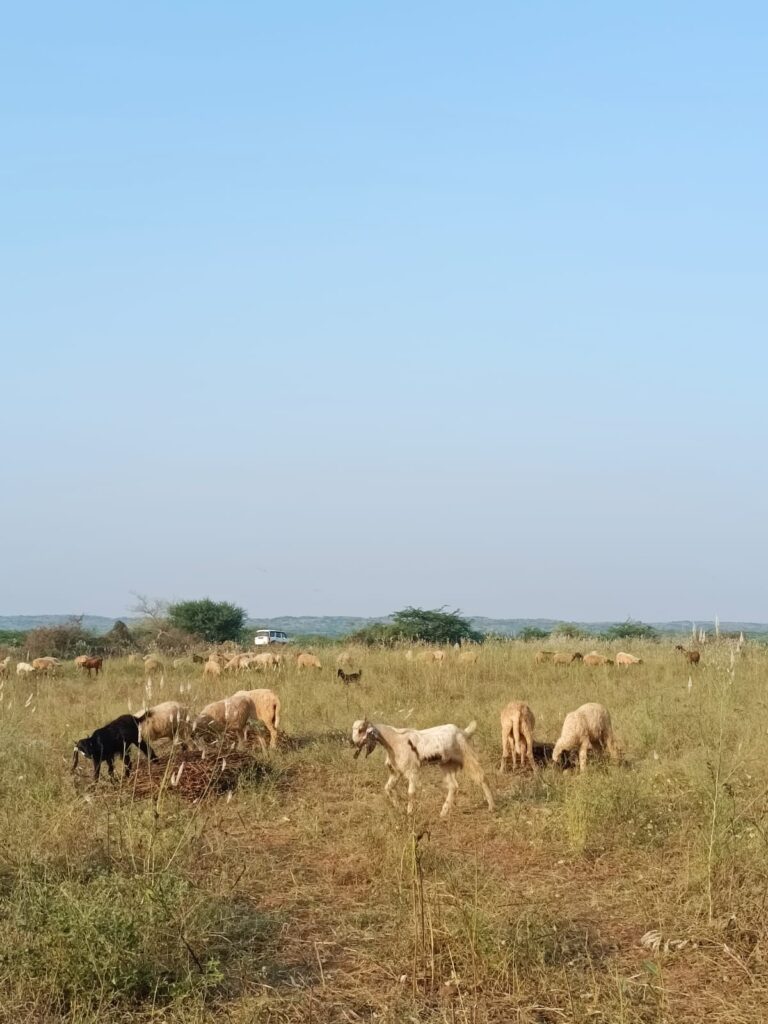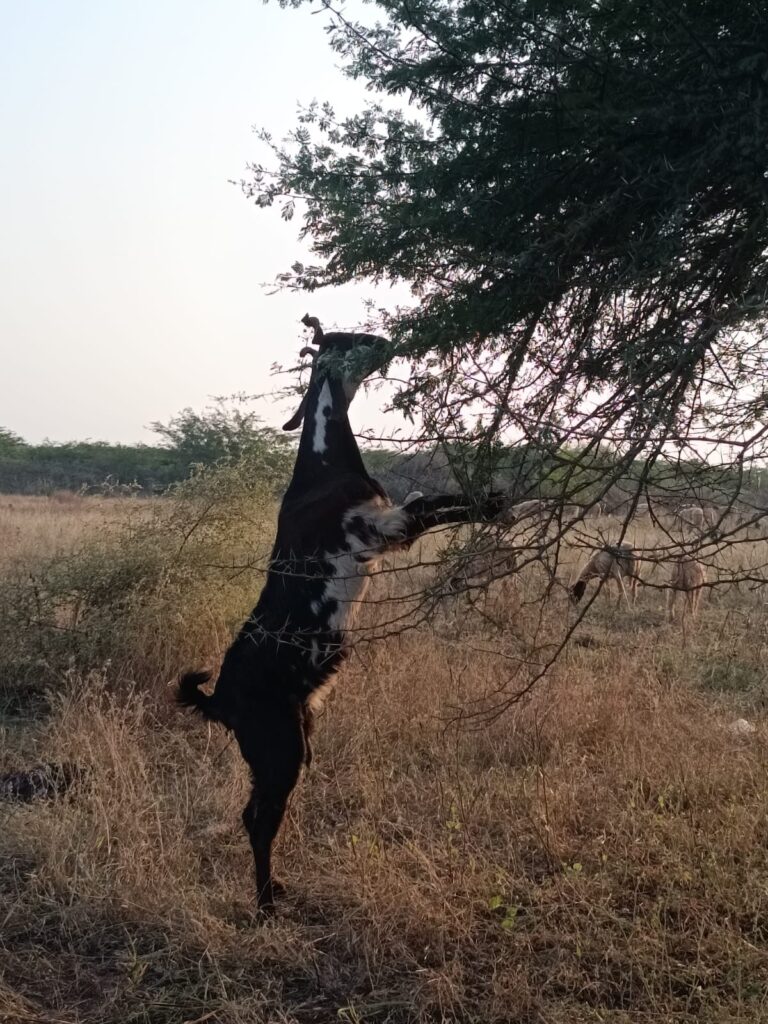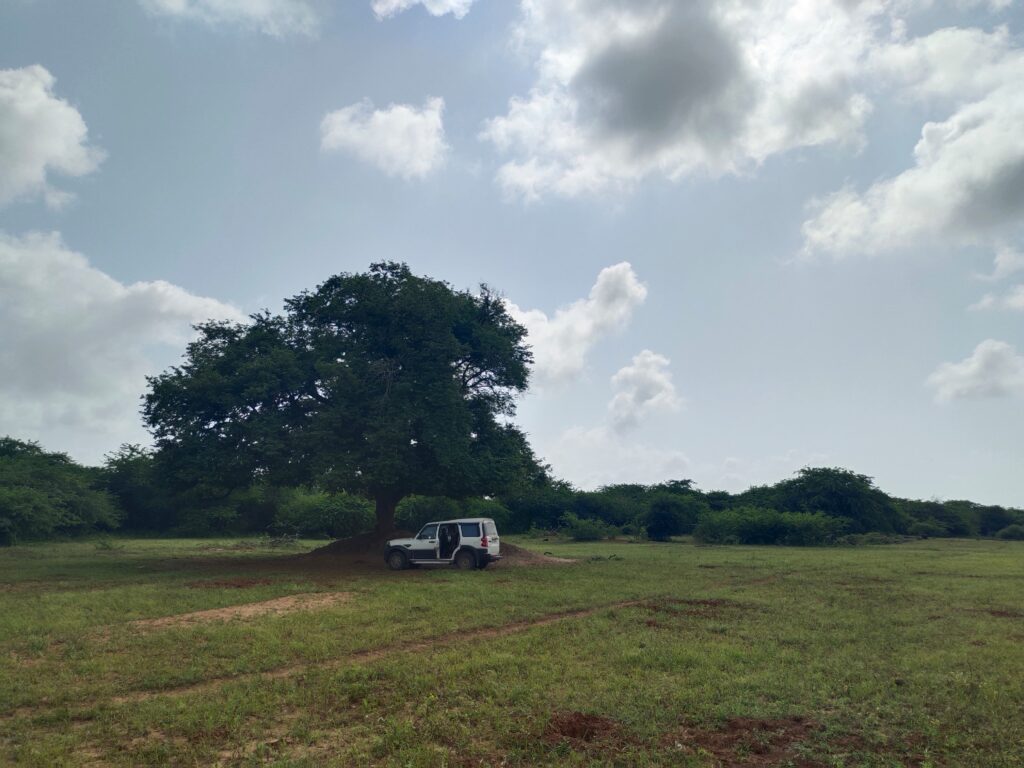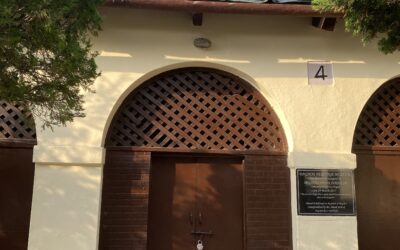On NH 754K, the road connecting Bhuj to Narayan Sarovar, one encounters an abundance of Prosopis juliflora (locally known as gando bawal). This invasive species has overtaken much of Kutch’s landscape, including the thorny forests of the western region.
Approximately 10km from Narayan Sarovar lies a small village, Khayyari, nestled within dense patches of gando bawal. This village consists of a couple of dispersed hamlets and an elementary school. In one of these hamlets resides an extended Rabari family (a pastoralist community in Kutch), united under a single patriarch. This hamlet comprises of about 12-13 households. The entire community engages in sheep and goat rearing as their primary livelihood.
During one of my field visits, I engaged with the community members and learned that their mul vatan (native homeland) was Anjar. They had migrated to Lakhpat and settled here around 25-30 years ago. Curious about their decision to leave Anjar, I inquired further, but none of the younger women could provide an answer.
Finally, an elder, kaaki (who shall remain nameless), shared that in Anjar they were camel pastoralists. Since camel pastoralism was no longer sustainable, they were forced to shift to sheep and goat rearing in the thorny forests of Lakhpat. This, to them, appeared to be the only viable option at the time.
The Decline Of Camel Pastoralism And Its Moderate Revival
Camel pastoralism in Kutch is declining, driven by several factors. Camel population has decreased to about 75% in India between 1992 and 2019. Rapid industrialisation and mining boom post the 2001 earthquake led to widespread encroachment of common grazing lands, which are vital for herders to sustain their livelihoods. The Kharai camel, a unique breed known for its ability to swim and feed on mangroves, has been severely affected by the reduction in mangrove cover.
Additionally, industrial infrastructure like ports has disrupted water flow, perishing the ecosystem. Moreover, government policies restricting access to protected areas have further decreased the herders’ ability to migrate freely.
The Rajasthan government’s decision to ban camel trade in 2015 has disrupted traditional markets, leading to reduction in demand for camels.
Efforts to address these challenges, though significant, have not been sufficient to reverse the damages caused. Initiatives such as the formation of Kutch Unth Uccherak Maldhari Sangathan (KUUMS) and the recognition of Kharai camels by the National Bureau of Animal Genetic Resources are critical steps toward conservation. The development of a camel milk-value chain, in collaboration with brands like Amul and Aadvik, has opened up new avenues to the pastoralists. Furthermore, collaborative efforts to regenerate grazing areas and restore water bodies have attempted to mitigate the impact of industrialisation.

Nonetheless, these measures are only addressing the symptoms and not the root causes. The degradation of grazing commons, regulatory constraints, and other socio-economic changes still continue to threaten livelihoods of the pastoralists.
For the true revival of camel pastoralism, there must be stronger legal protections for commons, large-scale mangrove restoration, and enhanced market integration for camel products is necessary. KUUMS and Sahjeevan are working towards holistic, long-term development. However, certain changes, such as the shifting of families from one livestock to another, could not be reversed.
Goat And Sheep Rearing As The Only Possible Alternative
The Gheta Bakri Maldhari Sangathan (GBMS) is an institution of sheep and goat-rearing pastoralists in Kutch (primarily based in Lakhpat). Established with the support of Sahjeevan in 2016, GBMS addresses the intricate challenges of the pastoral communities in the region. These challenges include maintaining livestock health, restoring degraded grazing commons, securing pastoralists’ rights under the Forest Rights Act (FRA), and diversifying income through initiatives such as the wool-value chain. It also tackles the pressing issue of Prosopis juliflora, and advocates for compensation for livestock losses.


Institutions like GBMS are significant in the context of preservation of pastoral livelihoods. Pastoralists, who rely on commons for grazing, have been severely impacted. One reason is the widespread presence of Prosopis. This invasive species not only reduces grazing resources as it has no natural control agent and exhausts groundwater. GBMS provides a platform for the community to collectivise its efforts in the removal of this invasive species. In addition, the institution also strengthens communities to advocate against illegal land encroachment for industrial expansion and renewable energy installations.
Another area of focus is addressing the undervalued wool-value chain. While most pastoralists primarily rear sheep and goats for meat, wool provides an additional income stream. However, the absence of formal markets has impacted its potential.
GBMS strives to work to promote wool as a viable product and connect the community to markets, facilitating to diversify their livelihoods and build resilience.
Moreover, GBMS advocates for fair compensation for livestock losses. While cattle and other livestock herders receive support, pastoralists raising sheep and goats are often overlooked in compensation schemes. By engaging with policymakers, GBMS aims to address this and ensure that small ruminant herders are adequately supported.
Despite its efforts, the institution faces several challenges, from ecosystem degradation to policy backlash. However, it remains an indispensable platform for pastoralists, safeguarding their rights, promoting sustainable practices, and ensuring their voices are heard. Along with protecting pastoral livelihoods, GBMS also contributes to the ecological and cultural preservation of Kutch.
Hope

The decline of pastoralism in Kutch highlights the urgent need for strong and effective institutions to secure pastoral rights. Traditional livelihoods such as animal herding are under threat due to industrial encroachment, environmental degradation, and restrictive policies. Institutions like the GBMS offer a promising way forward by addressing these complex challenges and ensuring their rights and claims under the Forest Rights Act.
The FRA provides a legal framework for communities dependent on forest resources by allowing them to claim collective and individual titles over commons that are vital for their sustenance.
Additionally, institutions in such cases play a pivotal role in facilitating these claims by mapping grazing routes, organising communities, and advocating for their rights. By empowering pastoralists to assert their claims under the FRA, these institutions ensure the protection and regeneration of commons. Hence, these institutions are the cornerstone of preserving pastoralism. Pastoralists not only protect a way of life but also ensure the ecological and cultural sustainability of regions like Kutch, where pastoralism has long been foundational for identity and resilience.




0 Comments